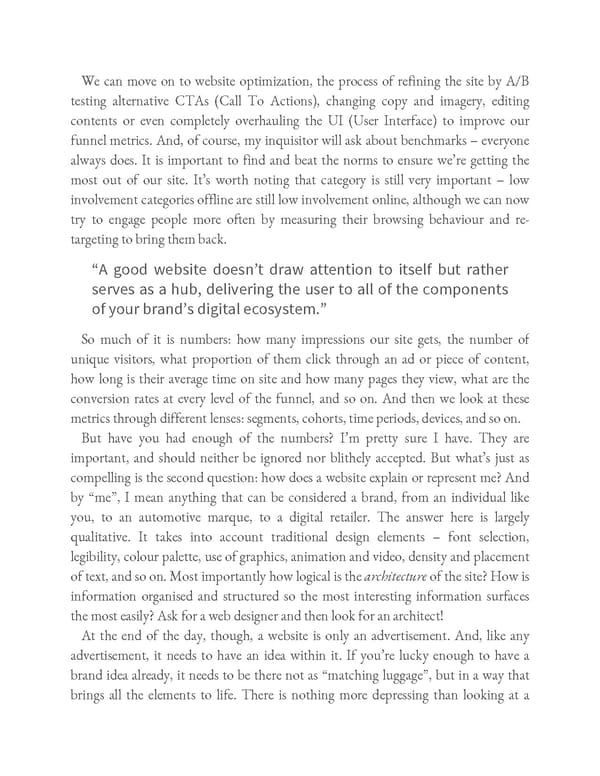We can move on to website optimization, the process of refining the site by A/B testing alternative CTAs (Call To Actions), changing copy and imagery, editing contents or even completely overhauling the UI (User Interface) to improve our funnel metrics. And, of course, my inquisitor will ask about benchmarks – everyone always does. It is important to find and beat the norms to ensure we’re getting the most out of our site. It’s worth noting that category is still very important – low involvement categories offline are still low involvement online, although we can now try to engage people more often by measuring their browsing behaviour and re- targeting to bring them back. “A good website doesn’t draw attention to itself but rather serves as a hub, delivering the user to all of the components of your brand’s digital ecosystem.” So much of it is numbers: how many impressions our site gets, the number of unique visitors, what proportion of them click through an ad or piece of content, how long is their average time on site and how many pages they view, what are the conversion rates at every level of the funnel, and so on. And then we look at these metrics through different lenses: segments, cohorts, time periods, devices, and so on. But have you had enough of the numbers? I’m pretty sure I have. They are important, and should neither be ignored nor blithely accepted. But what’s just as compelling is the second question: how does a website explain or represent me? And by “me”, I mean anything that can be considered a brand, from an individual like you, to an automotive marque, to a digital retailer. The answer here is largely qualitative. It takes into account traditional design elements – font selection, legibility, colour palette, use of graphics, animation and video, density and placement of text, and so on. Most importantly how logical is the architecture of the site? How is information organised and structured so the most interesting information surfaces the most easily? Ask for a web designer and then look for an architect! At the end of the day, though, a website is only an advertisement. And, like any advertisement, it needs to have an idea within it. If you’re lucky enough to have a brand idea already, it needs to be there not as “matching luggage”, but in a way that brings all the elements to life. There is nothing more depressing than looking at a
 Ogilvy on Advertising in the Digital Age Page 245 Page 247
Ogilvy on Advertising in the Digital Age Page 245 Page 247